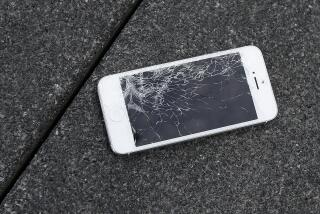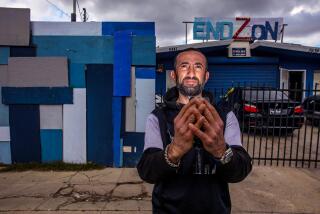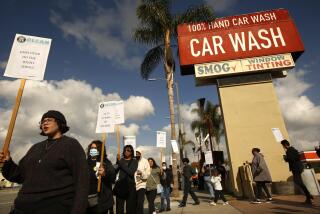The Science of Auto Body Repair
- Share via
Don Long owns a high-tech business full of computers and electric eyes and sonar pulses and advanced filtration and high-temperature finishing and sophisticated tracking and badly dented cars.
Long owns Walnut Valley Auto Body & Towing in Walnut, one of the largest and most technologically advanced auto body repair shops in the nation.
For the record:
12:00 a.m. Sept. 4, 1996 For the Record
Los Angeles Times Wednesday September 4, 1996 Home Edition Business Part D Page 2 Financial Desk 1 inches; 25 words Type of Material: Correction
Trackside Auto--The World Wide Web home page of Trackside Auto Center in Burbank was listed incorrectly in Monday’s paper. The correct address is https://www.tracksideauto.com/
Yes, even the auto body repair business, built with blowtorches and funny-looking hammers, has joined the technology age. Auto body repair shops can even be found advertising on the Internet.
“Twenty years ago, who would have thunk it?” quipped Charlie Barone, technical editor of Automotive Body Repair News in Radnor, Pa.
“Customers used to be afraid to sit down because you were afraid of sticking to something,” said Barone, who once ran his own auto body repair shop. “Now auto body shops have attractive waiting rooms with plants. They’ve got guys in ties who are customer service representatives. . . . The shops all have to have computer-literate people working there.”
Computers and other technoid innovations have shortened the average time needed to repair a crunched car.
But the expense of technology combined with the cost of complying with environmental and other regulations have also hoisted the price of making a car look as good as new. This price is borne first by car insurers, who presumably could pass it on to consumers if allowed to by the regulators who control insurance rates on a state-by-state basis.
The business of fixing car bodies has become more advanced because cars have become more advanced. Unibody construction, impact-resistant metals, increased use of plastics and special paints have all created the demand for more sophisticated tools and measuring devices.
“ ‘Computer’ is the key word. It’s the buzzword now for everyone,” said Long, whose 50,000-square-foot operation on three acres in a business park in the east San Gabriel Valley has attracted visitors from six countries in the last year curious to see how his operation works.
Trackside Auto Center in Burbank is much smaller than Walnut Valley Auto Body, but it has a similar technological bent. Only Trackside has gone online.
The Burbank company recently launched a home page on the World Wide Web that features a tour, with pictures, of the 10,000-square-foot facility. The site (https://www.trackside.com) also sports pictures of a restoration-in-progress of a 1957 Austin Healey 3000, a newsletter and a form to request an online estimate.
Trackside Manager Eugene Dold, who built the home page, said the company has gotten 12 jobs from the Internet since the site was introduced nearly two months ago.
“Over the past 15 years, the industry has gone through a serious technological revolution,” said Bill Conway, executive director of the California Autobody Assn., a Sacramento-based trade group. “Now it’s very high-tech.”
“It used to be very easy to get into the business,” Conway said. “Now I’ve heard it takes half a million dollars just to begin in business.”
Walnut Valley Auto Body is unusually large in an industry where most shops still have only five or six employees. The shop, which employs 130 people and expects revenue of $12 million this year, fixes more than 300 cars a month.
When Long opened a 1,500-square-foot shop in 1978, all he had were his hand tools, an air compressor, a frame machine, a 16-year-old helper and $20,000 in debt.
A car back then was a shell attached to a frame. As long as everything looked OK and the doors, windows, hood and trunk opened and closed all right, then the repairer had probably gotten close enough.
But car bodies are different now, manufactured more in one piece with the frame. The fit is tighter, and the cars are made of impact-resistant metals that must be handled correctly if they are to retain their special properties. Many pieces are plastic.
Close enough doesn’t cut it anymore, Long said as he fiddled with a machine called the Shark, which uses sonar to determine if a car is out of alignment by as little as a millimeter, the thickness of a dime. Out of trim more than that and a door won’t close or a hood won’t lie flat.
“We’re trying to stay on the cutting edge of new technology,” Long said. “We’re the test site for a lot of new stuff.”
The Shark also serves to document what shape a car was in when it arrived and what shape it was in when it left, a key issue in the image-conscious industry. In 1994, a report by the state Bureau of Automotive Repair found widespread fraud and incompetence in the California auto body repair industry.
The industry contended that the report’s criticisms were too broad, creating the impression of a general problem that did not exist.
“The insurance companies ride tight control on auto body shops,” Long said. “We’re audited on a weekly basis. That causes us to be especially cognizant of what we say we’re going to do and to make sure that we do it.”
The repair process begins with computerized systems to arrive at estimates for insurance companies. Pictures of damaged cars are also sent by computer to insurers.
Virtually every step has some high-tech application to improve accuracy or to comply with environmental regulations, which are many.
The company’s 25 tow trucks are all equipped with tracking devices so that dispatchers can route them more efficiently.
A computerized frame machine pulls a car back into shape, and another computerized machine aligns the wheels.
An electric eye scans the car’s color and matches it to a formula in the computer, even if the color has faded in the sun. Paint is measured out by another computer that is sensitive enough to register the weight of a fly.
Paint is sprayed on in a booth that then bakes the car to 160 degrees, which activates agents in the paint that make it cure from the inside out. Infrared lights contribute to the drying process, which takes about an hour and 10 minutes.
All the paint dust that is sanded off a car is sucked through a filter to keep it from polluting the air. Paint usage must be strictly tracked to comply with Air Quality Management District emission rules. Cameras throughout the facility allow Long to keep tabs on any car on television monitors in his office. “That way if a customer calls I can say, ‘I see your car right now. We’re working on it,’ ” Long said.
Environmental regulations and the cost of high-tech equipment have increased the expense of doing business. The price of auto body repair has “unquestionably” risen during the past several years, said Barone of Automotive Body Repair News. Not only are the machines more expensive, but so are basics such as paint. The specially formulated paint that is required by pollution regulations costs between $150 and $250 a gallon, compared with $20 10 or 15 years ago.
Technology presents a work force problem because public schools channel students with poor academic skills into automotive classes that don’t prepare them for the rigors of a real shop, Long said.
“We’re finding that we can’t accept the people who were forced to go to the automotive side in high school because they couldn’t conform to the scholastic side. They need the algebra and the math to run the machines,” he said.
Despite Long’s interest in computers and his facility with every gadget in his business, there is one automotive innovation of proven worth that Long resists:
“I still hate to wear my seat belt,” he said.
Business writer Nancy Rivera Brooks can be reached at nancy.rivera-brooks@latimes.com
(BEGIN TEXT OF INFOBOX / INFOGRAPHIC)
Some examples of the changes:
Task: Figure out how badly a car is out of alignment or whether you’ve succeeded in putting it back into alignment
Now: Hook the car up to computerized measuring systems that use sonar or lasers to determine if the car is as little as 1 millimeter out of whack
Then: Pull out a tape measure and eyeball it
*
Task: Return the car to proper alignment
Now: Place the car on a specialized robotic rack that nudges the car back into the correct shape
Then: Chain the car to a fixed object, hook another chain to the opposite end and yank; use a sledgehammer if needed
*
Task: Repair damaged paint
Now: Place the car in a paint booth where the proper color is applied and emissions are recaptured to avoid harming the environment
Then: Spray the car in the shop or outside using a one-gallon pain pot and a spray gun.
*
Task: Dry the paint
Now: Bake the paint at high temperatures or leave under infrared lights until dry (about one hour, 10 minutes); paint surface is washable four hours later
Then: Leave the car out in the sun after painting; it might be dry in a day or so; don’t wash for at least two weeks
*
Task: Match the new paint to the old color
Now: CD-ROMs from paint manufacturers give precise directions for mixing colors for various car models; a computer with an electric eye can scan an individual car and match its color, even if faded, to the formulas on hand with 90% accuracy
Then: Take out your six stock colors and make a good guess






